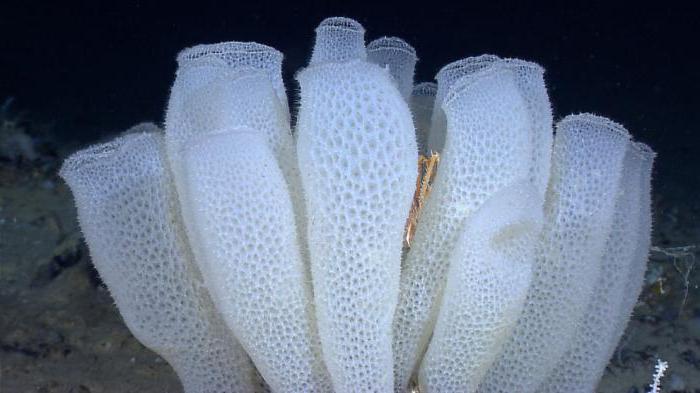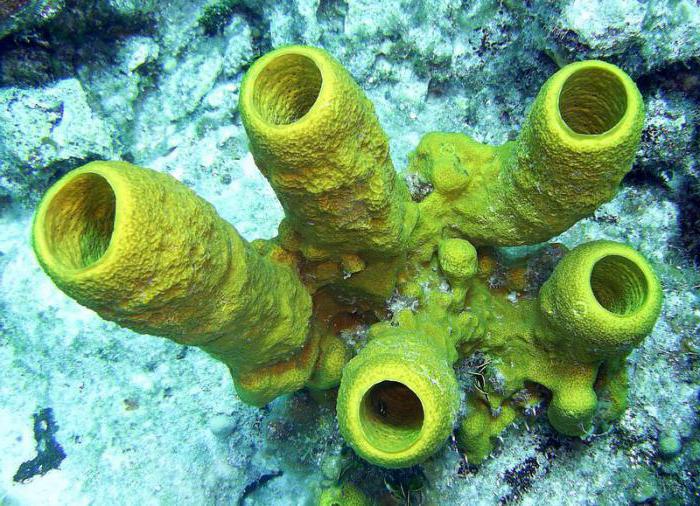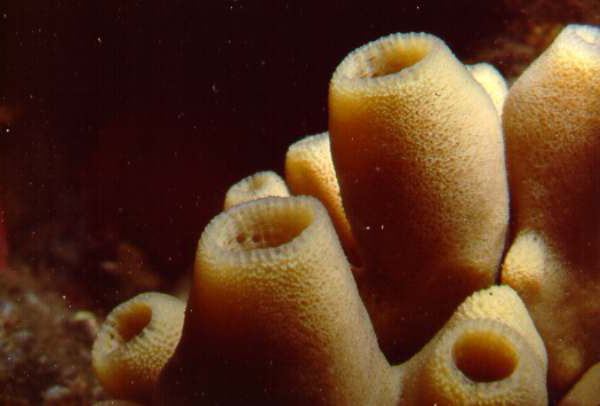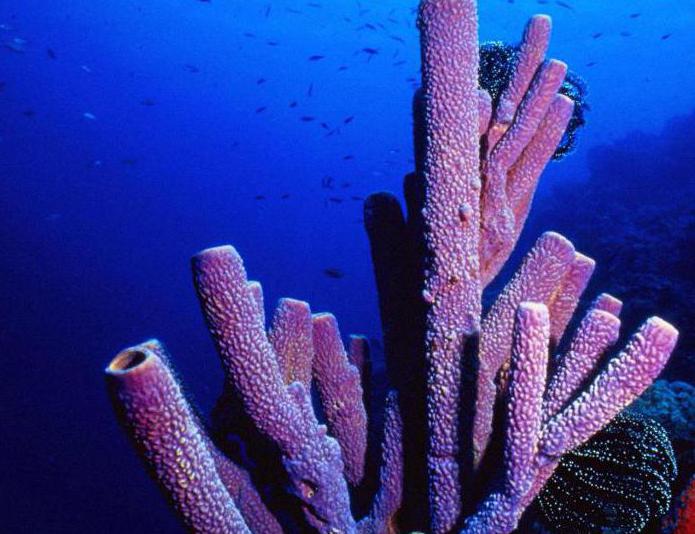Sponge type, the structural features of which we will consider in our article, are still a mystery of nature to this day. And in textbooks on zoology, there is not so much information about them. But sponges are a type of multicellular animals and are widespread in nature.
Subkingdom Multicellular
Over time, as a result of evolutionary transformations, along with the simplest in nature, multicellular animals also appeared. They have a number of more complex structural features. And the point is not only in the number of cells, but in their specialization to perform various functions. Some of them serve for reproduction, others provide movement, and still others - the processes of splitting substances, etc.
Groups of cells, identical in structure and function, are combined into tissues, and they, in turn, form organs.
Sponge type: general characteristics
Sponges are the most primitive multicellular animals. They do not yet form true tissues, but cells are distinguished by strict specialization.
Sponges are ancient animals. Some of their species have been known since the Precambrian and Devonian periods. Scientists consider calcareous flagellates to be their ancestors. But the branch of evolution of sponges turned out to be a dead end.
For a long time, taxonomists could not determine their position in the system of the organic world. Therefore, sponges were called zoophytes - organisms that have signs of both animals and plants. Everything changed only at the beginning of the 19th century. Sponges were finally assigned to the animal kingdom. But scientists are still arguing: whether these are colonies of protozoa, or real multicellular organisms.
Basics of classification
According to the types of structure of sponges, they are combined into several classes:
- Ordinary. Among them there are solitary and colonial forms. They look like growths, plates, lumps, small bushes, the height of which can reach half a meter. Representatives of this class are badyagi, toilet and drilling sponges.
- Lime. They are characterized by the presence of an internal skeleton, the needles of which are composed of calcium carbonate. The shape of the body is in the form of a barrel or tube. Representatives are sicon, ascetta, leucandra.
- Coral. Exclusively colonial forms. The internal skeleton is composed of calcite or silicon. The size of the colonies in width reaches a meter. They got their name due to the fact that they live among the coral reefs of the Indian and Pacific Oceans.
- Glass, or Six-beam. Solitary goblet-shaped specimens. They have a skeleton made of silicon in the form of needles. They live exclusively in ocean waters. Due to their aesthetic appearance, they are used for making jewelry.

Structural features
Most representatives of the Sponge type have a goblet body. With its base, the animal is attached to the substrate - stones, the bottom of reservoirs or shells. The upper part opens outwards with a hole leading into the body cavity. It's called atrial.
All Sponge-type classes are two-layered animals. Outside is the ectoderm. This layer is formed by squamous cells of the covering epithelium. The inner endoderm is made up of flagellar cells called choanocytes.
The walls are not continuous, but penetrated by a large number of pores. Through them, the exchange of substances of sponges with the environment occurs. Between the layers of the body is a gelatinous substance - mesoglea. It contains three types of cells. These are the supporting ones that form the skeleton, sexual and amoeboid. With the help of the latter, the process of digestion is carried out. They also ensure the regeneration of sponges, since they can turn into any type of cell.
The size of the sponges varies from 1 cm to 2 m, and the color is from cloudy brown to bright purple. The shape of the body is also different. Sponges can look like a plate, a ball, a fan or a vase.

Nutrition
According to the method of feeding, representatives of the Sponge type are heterotrophic filter feeders. Water constantly moves through their body cavity. Thanks to the activity of flagellar cells, it enters the pores of the layers of the body, enters the atrial cavity and exits through the mouth.
At the same time, protozoa, bacteria, phytoplankton and the remains of dead organisms are captured by amoebocytes. This happens by phagocytosis - intracellular digestion. Unprocessed food remnants again enter the cavity and are thrown out through the mouth.
Among the sponges there are also predators. They do not have an aquifer filtration system. They feed on small crustaceans and fish fry, which stick to their sticky threads. Then they shorten, pulling themselves up to the body of the predator. The sponge wraps around the prey and digests it.

Respiration and excretion
Animals belonging to the Sponge type are not found on land. Therefore, they are adapted to absorb oxygen only from water. This happens with the help of diffusion. All cells of the body of sponges are capable of absorbing oxygen, as well as removing carbon dioxide.

asexual reproduction
Despite the primitiveness of the structure, the methods of reproduction of sponges are quite diverse. They can reproduce by budding. In this case, a protrusion appears on the body of the animal, which increases in size over time. When all types of cells have formed on such a kidney, it detaches from the maternal individual and proceeds to an independent existence.
The next way sponges reproduce is fragmentation. As a result, the body of the sponge is divided into parts, each of which gives rise to a new organism. This process is also called gemmulogenesis. It usually occurs with the onset of adverse conditions.
The resulting parts of the sponges are called gemmules. Each of them is covered with a protective shell, and inside contains a supply of nutrients. Gemmules are considered to be the resting stages of sponges. Their ability to survive is simply incredible. They remain viable after exposure to low temperatures down to -100 degrees and prolonged dehydration.
sexual reproduction
The sexual process is carried out by specialized cells. In this case, the spermatozoon leaves the mouth of one sponge and enters the other with a current of water. There, amoebocytes deliver it to the egg.
According to the type of development among the sponges, oviparous and viviparous are distinguished. In the former, the division of the fertilized egg and the formation of the larva occurs outside the maternal organism. Such organisms are always dioecious. Among viviparous representatives, hermaphrodites are often found. In them, the development of the zygote is carried out in the atrial cavity.

Ecology
For the distribution of Sponge-type animals, the presence of a certain substrate is of great importance. It must be solid, as silt can clog into the pores. This leads to mass death of animals.
A characterization of the Sponge type would be incomplete without mention of symbiosis. In nature, cases of their mutually beneficial cohabitation with other aquatic inhabitants are known. It can be algae, bacteria or fungi.
With this form of existence, the metabolism of sponges occurs more intensively. For example, when cohabiting with algae, they release several times more oxygen and organic matter. Since adult sponges are inedible, many animals use them to protect themselves from enemies. There are cases when crustaceans settle in them. And crabs prefer to wear sponges on their shells.

Significance in nature and human life
Sponges are of great importance for cleaning water bodies. By filtering, they not only feed, but also remove impurities. These animals also play their role in food chains. Sponge larvae feed on mollusks and certain types of fish.
For humans, sponges are raw materials for pharmacology. Everyone knows ointments for bruises and bruises based on sponges - badyagi, as well as iodine-containing drugs. The meaning of these animals is also associated with their name. They have been used for a really long time for washing the body and various surfaces. And now we call such synthetic products sponges.
So, in the article we examined the representatives of the sub-kingdom Multicellular - the type of Sponge. These are multicellular aquatic animals that lead an attached lifestyle. In their body, two layers are distinguished - ecto- and endoderm. Each of them is formed by specialized cells. Sponges do not form true tissues.
